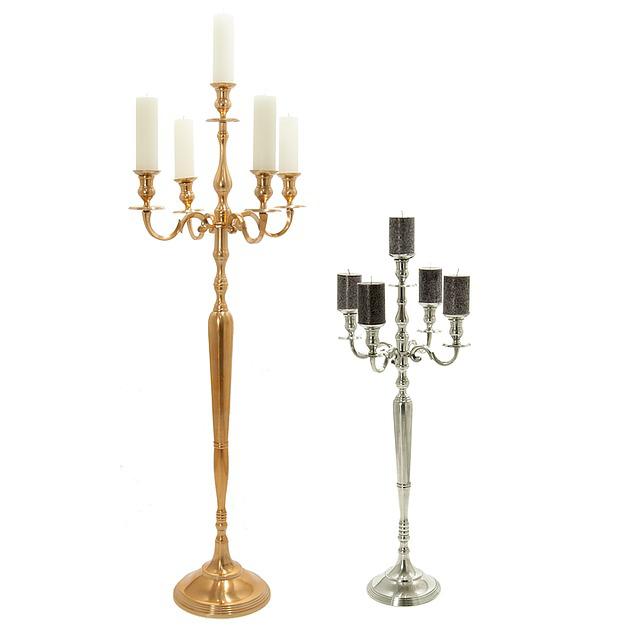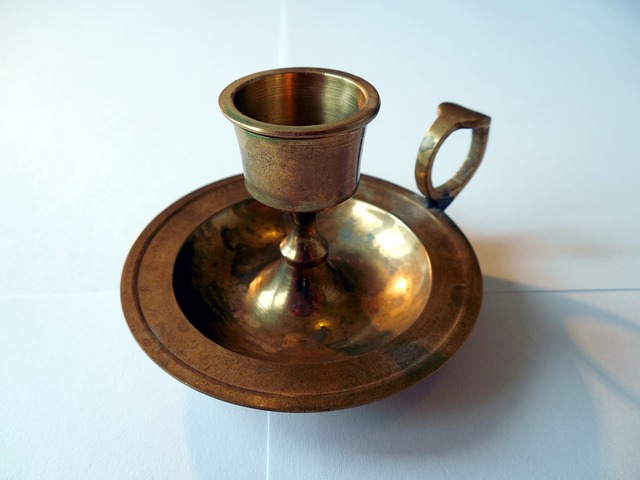Candles are always a cozy and inviting appearance in a space. Candlelight may provide people peace of mind, whether it is used to hold a delicate supper in the middle of the dining table, is set just so on the fireplace, or adds some ambiance to a soothing bath. But all of these drawbacks might be lessened if your candlestick is extremely black. If it is not maintained consistently, brass in particular is susceptible to color changes.
Copper candlesticks were an essential type of functional decorative item before electricity was discovered. They were created by great craftsmen and artisans, and they were both useful and beautiful. Wax pot, nozzle, fireplace, capital, shoulder, stem, column, ball, and well are among the components of an antique brass candlestick. The article will give easy tips on how to clean brass candlesticks.
Table of Contents
How Often To Clean Brass Candlesticks?
For some, the appeal of brass is its tarnish—for a good reason, as tarnished brass can look beautifully vintage in the right circumstances. If you’re trying to preserve tarnishing rather than getting rid of it, you’ll want to clean your brass candlesticks far less often—maybe a quick monthly dusting when you start to notice an excess of dirt.
But if you’re looking for a sparkly shine rather than a dull luster, you’ll need to clean them whenever they start showing signs of dirt, dust, stains, or smudges. Depending on where your candlesticks are located (and how often they’re used), this can be anytime from every week to every few months, as candlesticks that are handled a lot or that are in dustier areas will need more frequent cleaning.
Methods Of How To Clean Brass Candlesticks
Lacquer
Determine whether your brass is lacquered or not before applying any polish. To prevent tarnishing, some brass objects are coated with a very thin layer of lacquer. This lacquer will peel and flake off over time.
If a piece is shiny, that is a dead giveaway that it has been lacquered. The object was likely lacquered if it still had a lot of shine and brightness. You can carefully inspect the piece to check for flaking.
If the item is lacquered, all that needs to be done is to use a sponge to wash the brass in hot, soapy water. Gently buff it with some flannel, and it will be fine.
Brass Or Brass-plated
Knowing if your item is solid brass or brass-plated is crucial. Put a magnet on the object; if it is made of solid brass, it will not stick. Never use harsh scrubbing techniques or commercial brass cleaners on brass-plated objects. Commercial polishes with powerful abrasives or hand washing could remove the coating and harm your piece.
Whether Or Not To shine
a variety of tarnished brass objects.
My beloved brass collection. Some of them have gotten a little too adored.
You should think about whether you should polish your brass before you do. An element of the attractiveness of well-aged brass is its patina. Additionally, if the item is an antique, attempting to polish it can reduce its worth. Your best course of action may be to
Candlesticks
The removal of candle wax should be one of your initial cleaning steps for brass candlesticks. For 15 to 20 minutes, freeze your candlesticks. The majority of the wax will immediately pop off or be simple to peel off as you remove them.
Use a hairdryer to gradually warm any remaining wax and wipe it off. Then, use a cloth dipped in white vinegar to wash away any leftover wax.
Saline Hot Water
Before trying anything else, wash your brass in hot, soapy water. Sometimes, just doing this is enough to bring back the shine and brilliance. If not, it prepares the item and increases the potency of any of the natural cleaners and polishes that follow.
Lemon Juice & Salt
This solution is only suitable for parts with slight discoloration. Cut the lemon in half and sprinkle the cut side with salt. Wipe off the copper with pickled lemon. Let the cake sit for a few minutes before wiping off the lemon juice and salt with a clean soft cloth. Polish the workpiece gently to restore luster.
Lemon Juice & Cream Of Tartar
A paste of tartar cream and lemon juice was used to clean brass.
For the more difficult jobs…
For stubborn discoloration, mix lemon juice and cream of tartar into a paste. Apply the paste to the copper tube using a clean soft cloth or pastry brush. Let the copper pipe sit for 10-20 minutes, then rinse with warm water. Dry this and polish it lightly with a soft cloth.
Ketchup
Ketchup is used to clean brass.
Please pass me the ketchup.
No lemons? Grab the ketchup.
The acid in tomatoes is a good stain remover. The consistency of ketchup makes it easy to apply to candlesticks, sculptures, and bookshelves.
Coat the ketchup with your color-changing brass and let it sit anywhere for 5-15 minutes, then rinse off with warm water. Dry your copper pipe and it will be as good as new.
Tomato Juice
Dip the copper Candlestick into tomato juice and wash it by hand.
Hand-dipped candles should be equipped with a shiny hand-dipped candlestick.
Tomato juice is a good choice for brass pieces, which may be quite complex, and entering corners and cracks may prove difficult by other methods. You can soak the whole piece of Tomato in tomato juice to remove the hard-to-reach stains.
Let the copper slice soak in tomato juice for 10-30 minutes, depending on the corrosion degree of the copper slice. You can check the work every few minutes to see how it is progressing. Just rinse out the tomato juice and wipe the copper pipe dry.
Flour, Salt, And Vinegar
Flour, vinegar, and salt are used to clean brass.
Are we baking or cleaning?
Mix a teaspoon of salt with a quarter cup of vinegar. Now add enough flour and stir it into a paste. You want it to be thick enough to stick to brass. Put the slurry on the copper sheet and let it stand for 5-15 minutes. The length of time depends on the dirty degree of the copper sheet.
Wash the paste off and dry the brass with a clean towel.

Tin Foil & Baking Soda
Immerse the brass plate in boiling water and add aluminum and baking soda.
For those who like chemistry, try this method.
This is probably one of the easiest ways to clean brass.
Put tin foil on the baking tray or bowl, making sure the shiny side is up. Sprinkle baking soda on the bottom of the plate. Now put your copper pieces on a plate and pour enough boiling water to drown them.
Let it immerse in water for about 15 minutes.
A neat chemical reaction (I’m not good at explaining) will occur, in which the tarnished copper and aluminum foil are combined. In particular, tarnished parts may need to be soaked twice in this way. This method also applies to silver.
Warm Water & Mild Soap
Some brass candlesticks are simply brass-plated; others are made entirely of brass. Put a magnet on your candlesticks to see if they are brass-plated. Your candlesticks are brass-plated if the magnet sticks to them. You can also lacquer your brass, which means that a clear coat of lacquer is applied to the brass to keep it bright. In either of these situations, it’s crucial to clean the candlesticks carefully because any abrasives that are too harsh can destroy the plating or lacquer.
Warm water combined with a few drops of mild soap makes cleaning brass-plated or lacquered candlesticks simple. Gently rub the mixture onto the candlesticks with a lint-free cloth, then wipe it off and let it air dry.
Lemon Juice & Baking Soda
Brass candlesticks can also be cleaned using this tried-and-true cleaning combination. Because this cleaning procedure is harsh and can harm plating or lacquer, only use it on totally brass, non-lacquered candlesticks. Additionally, avoid rubbing the paste on too firmly because baking soda is quite abrasive and can scratch brass.
To begin cleaning brass candlesticks with baking soda and lemon, combine three tablespoons of baking soda with two teaspoons of lemon juice to make a paste. Apply the paste to the candlesticks gently, then leave it there for 30 minutes. Next, wipe it off with a damp cloth and rub it dry, just like with the ketchup approach.
Keep It Shiny
After working so hard to clean your brass, maintain its shine by applying a very thin layer of mineral oil or heated linseed oil. With a fresh piece of flannel, buff your piece and remove any extra oil.
Use food-grade mineral oil, such as that sold for laxative or wood cutting board conditioning, rather than the boiling linseed oil if your item is used for serving food.
Your piece will be shielded from the oils on your hands and oxygen oxidation, both of which will cause the brass to tarnish, by being coated with oil.
How To Clean Brass Candlesticks More Frequently
The best defense against tarnished and damaged candlesticks is prevention, so don’t add to your workload later by skipping a few (little) tasks along the way. First things first: after using your candlestick, make sure to brush off any extra wax that may have dropped on it.
Summary
The rich hue and warm shine of brass have a way of drawing the eye, which means it only takes one or two pieces in a room to pull you in. Like many things from the mid-century, brass is having a moment, and vintage brass pieces are being snatched up from thrift and antique stores everywhere.
Of course, grabbing some vintage brass usually means cleaning it as well. There’s no need to head to the store for a special brass polish, though. You’ve probably got an excellent brass cleaner in your cabinets.


